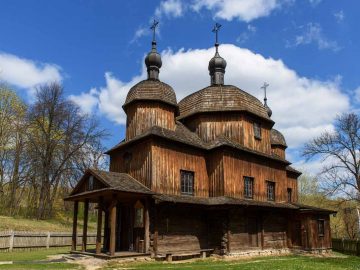Greek Catholic Orthodox Church of Tarnoszyn
– a festive interior design
For the time of Easter, the Greek-Catholic orthodox church in Tarnoszyn was given a suitable festive interior design.
The orthodox church from Tarnoszyn, located in the Lublin Open Air Village Museum, is the only church translocated into open-air museums in Poland, whose cult function has been restored. Being a museum object, it is at the same time a temple of the Greek Catholic Parish in Lublin under the invocation of the Nativity of the Blessed Virgin Mary.
The church, located in the Lublin open-air museum, was built in 1759 in the town of Uhrynów (in the Second Polish Republic it was the Sokalski poviat of Lviv voivodeship). In the years 1904-1906, it was moved to the village of Tarnoszyn (which is currently a poviat of Tomaszów Lubelski). Then it was translocated from Tarnoszyn to the Lublin Open Air Village Museum.
The trimodal construction is a wooden building with 3 domes covered with shingles. Tripartite with a vestibule, nave and chancel on the axis and two sacristies on both sides of the chancel. The assumptions of the exposition refer, to the possible extent, to the situation of furnishing the church in Tarnoszyn around 1939. In the museum’s interior design of the church, the few preserved monuments from Tarnoszyn were used. Most of the exhibits come from other Greek-Catholic temples in south-eastern Poland. The presbytery’s decoration most accurately reflects the interiors of Tarnoszyn. Considering that the original Tarnoszyn iconostasis from the early twentieth century has been preserved only partially, the iconostasis from the second half of the eighteenth century from the destroyed church in Teniatyska was incorporated into the interior, probably made by the painters of the so-called Żółkiew school.
Kategorie: News | Data dodania: 21 April 2020







